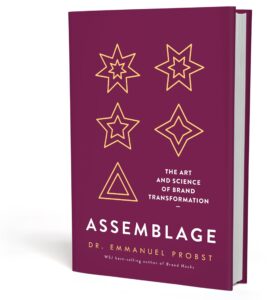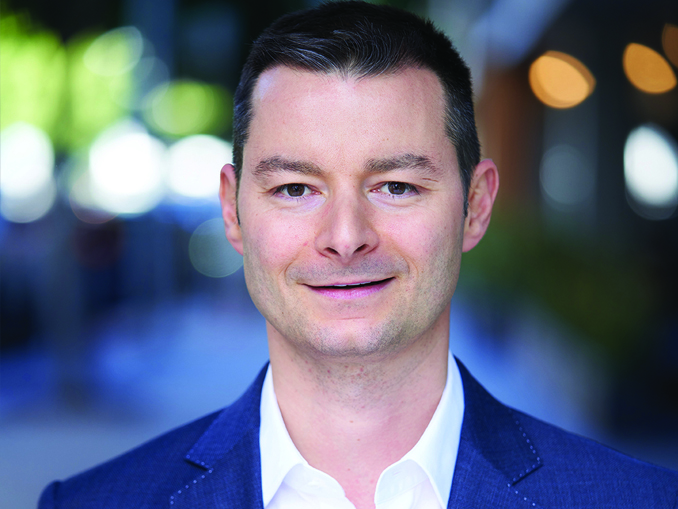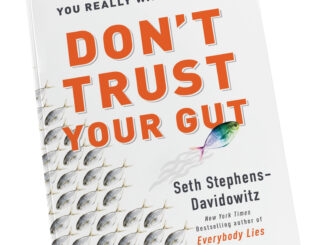 by Zoë Billington, User Research & Customer Insights, Santa Monica, California, zbillington@gmail.com
by Zoë Billington, User Research & Customer Insights, Santa Monica, California, zbillington@gmail.com
Interview with Emmanuel Probst, Global Lead for Brand Partnership, Ipsos
What do brandy and branding have in common? A lot more than their first five letters. Zoë Billington spoke with Emmanuel Probst, a branding thought leader, professor, and author, about how to build and evolve timeless brands using the principles of a winemaking technique called assemblage.
Zoë Billington: Thanks for speaking with me today, Emmanuel! To start off, could you introduce yourself and talk about some of the key experiences that led you to where you are today?
Emmanuel Probst: I’m the global lead for brand partnerships at Ipsos, one of the largest full-service market research agencies in the world. I’m also an adjunct at UCLA, where I teach consumer market research. I also write books, and my latest book is Assemblage: The Art and Science of Brand Transformation.
The honest truth about my starting point is that it was completely random. I needed a job to keep the cash coming in when I was studying, so I took a job at a market research firm to supervise a call center. Once I graduated, I came across a firm in London that was looking for someone with an understanding of market research and the business world, a postgraduate degree, and bilingual, and that’s how I started working in data collection.
From there, I never stopped. What was compelling then and is still compelling to me today is the opportunity to discover new things, understand why people do what they do, and share my knowledge with students and practitioners.
Zoë: Could you explain the concept at the center of your book—Assemblage—and why it matters for building successful brands?
 Emmanuel: Assemblage is a word inspired by winemaking, and the process is similar when making brandy, champagne, or whiskey. Just like creating a wine, when the winemaker creates a brandy, they will pick and choose from a wide range of different brandies to blend. They combine and assemble these into the final product, with the goal for the final product to be unique and distinctive compared with the brandies that came before them and, of course, to be on brand. In other words, it has to stand out while aligning with the brand’s identity.
Emmanuel: Assemblage is a word inspired by winemaking, and the process is similar when making brandy, champagne, or whiskey. Just like creating a wine, when the winemaker creates a brandy, they will pick and choose from a wide range of different brandies to blend. They combine and assemble these into the final product, with the goal for the final product to be unique and distinctive compared with the brandies that came before them and, of course, to be on brand. In other words, it has to stand out while aligning with the brand’s identity.
To succeed, brands must transform people and the world we live in—they must positively impact us. So, assemblage is really a metaphor because I believe that we can follow the same blending process in branding. That is, when creating a brandy, the winemaker combines a plethora of samples from different grapes, aging processes, and barrels. In a similar vein, brand managers can pick and choose from various attributes to create a brand that will stand out, be successful in the long run, and do so in a dynamic fashion.
Zoë: To help us understand what gets assembled when building a brand, how about an example? Can you tell us about a brand that you feel has nailed this idea of assemblage?
Emmanuel: A brand most of us are familiar with is the James Bond movie franchise. The core attribute of that movie franchise is: it’s a British spy triumphantly fighting against evil. However, many aspects have evolved over the years, and the brand has evolved in that regard. For example, his boss, M, is no longer a man; Q, the one who provides James Bond with his gadgets, is openly gay; Miss Moneypenny, the secretary of his boss, is a Black woman; and James Bond himself no longer fights the KGB and has evolved his behavior. Admittedly, he still has some work to do, but he is becoming more considerate of women and more empathetic toward the world around him. As such, the James Bond franchise is a dynamic assemblage of attributes that got updated in light of new social and cultural norms.
This all translates into great brand partnerships. When you think of James Bond, you think of Omega® Watches and Aston Martin, for example.
So that’s a great example of an assemblage: we keep what works with the big idea of a British spy who’s here to fight evil. We evolve everything else.
Zoë: How about a bigger, global company? How should they think about brand-building to appeal to such a wide range of consumers with different needs?
Emmanuel: A global brand needs a big idea that’s universal to fall back on. Then, this big idea needs to be adapted to local expectations, local imperatives, and local opportunities. So, for example, if Google’s purpose is to organize the world’s information and make it accessible to everyone, that’s universal enough. Next, how is Google going to make this happen across markets? Well, in Europe, it might mean a bit of catching people up on artificial intelligence. In the U.S., it might mean supporting small- and medium-sized businesses to market and monetize their businesses, maybe with Google Maps and Google Analytics. Then, in India, it might be about helping people transition from having no cell phone at all to suddenly having smartphones. Or, it might be about marketing a functional benefit of the Google Pixel camera that captures two skin tones. That’s an example of a great demonstration of brand purpose in action, whereby we not only respect but also shed light on different skin colors because the camera has the ability to capture it better. So, this is an example of another big idea that we can adapt over time in light of the priorities of different markets.
Zoë: You believe it’s more important now than ever for brands to think about their assemblage. Why is that?
Emmanuel: First, because technology enables us to communicate with brands directly. You’re no longer limited by broadcast media. Now a brand pushes a message that you hear on social media, and you’re able to react.
Second, we have been accustomed to even more communication with brands and products, especially as those products now get delivered to our doors.
The third reason is generational, whereby Gen X and boomers were not accustomed to talking back at brands and looking back at institutions in general. In sharp contrast, younger millennials, Gen Z, and Gen Alpha are much more inclined to talk back—and that’s a double-edged sword. We’ll see consumers advocate for a brand that does the right thing and potentially even cancel a brand that doesn’t do the right thing.
Zoë: Do you think these trends appeared at other times in the past, or are consumers’ expectations of brands new?
Emmanuel: I think brand purpose has been a buzzword for maybe 10 years now. But the big difference between now and then is that when brand purpose started, brands could just claim a purpose as if it were a bumper sticker. But now, especially after the pandemic, this purpose has to be congruent, it has to be realistic, and it has to be believable. It has to be something that a brand can stand by and stand for. In my view, that’s how this concept of purpose and brands doing the right thing and positively contributing to the world around us has evolved. Now they cannot just talk about it; they must also do it.
Zoë: So, what role do data and insights play in all this? We’ve talked about the role of the brand manager, but what about the researcher?
Emmanuel: Absolutely. Well, the good news is that we have access to more data than ever before. We also have tools to monitor not just social media listening but also legislative publications and news activity and signals, and so on and so forth. However, to quote Lew Pascal, who at the time was senior vice president of research at Bank of America, now what we have is marketers that are “data rich but insights poor.” This means we get lost in all the data, and we don’t know exactly what’s most significant and most actionable. In that regard, I think the role of insights professionals is even more important and prevalent than ever before. Technology will give you access to data. However, you will need someone to guide you through what really matters and what doesn’t and what decisions you can make based on these data.
Zoë: What advice would you give to our readers for building their own personal brand assemblages or evolving with these changes and the needs of their stakeholders?
Emmanuel: As insights professionals, I think the opportunity right now is not only to measure but also predict the impact of future brand communications and to optimize those communications. Provide guidance to your business or client on what to do next instead of just reporting performance. I think that’s a very important aspect of what we do in insights and what we can do differently.
A further opportunity for our readers is that marketers are becoming increasingly accountable for their spending. As insights professionals, you want to challenge yourself to measure metrics that will feel very tangible, very actionable, and very real for people beyond the market research function in an organization—for example, return on marketing spend, return on ad spend, customer lifetime value, and recency frequency purchase.
We can branch out to talk to consumer insights managers and market researchers, and the organization at large by providing them with metrics that they will understand and that will resonate with them.
Overall, I want to emphasize that I’m optimistic about the opportunity for insights professionals.
Zoë: It’s the buzzword of the day, so I have to ask—do you have any thoughts or predictions about how AI might impact the way brands and consumers interact, or consumers’ expectations of brands?
Emmanuel: I’m always wary of making predictions because they’re wrong at least part of the time, and we don’t have a crystal ball. But with that said, ChatGPT and generative AI are tools that will help us become more efficient and scale up. However, what these tools will not do, and that’s why I sleep very well, is give guidance and counsel.
The tools are just tools; you need to know how to use them. But, most importantly, you must be willing to take responsibility for them, and you need to use them to counsel on what to do next. So, I’m always going back to this opportunity for our readers to counsel their clients in foresight on what to do next.
Zoë: To wrap up, what are YOUR favorite brands right now?
Emmanuel: I still love Ralph Lauren. It’s one of the few brands that manages to translate from one generation to the next. In my opinion, it’s because Ralph Lauren has a strong leader who is a public figure, has communicated some very strong values around the American dream, and manages to market its value proposition through different channels relevant to today’s shoppers.
Zoë: Thanks again, Emmanuel; it was great speaking with you.
Podcasts Editor Mike Carlon has also recorded a podcast with Emmanuel Probst. Check out our Podcasts section to listen.





1 Trackback / Pingback
Comments are closed.